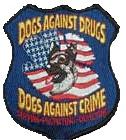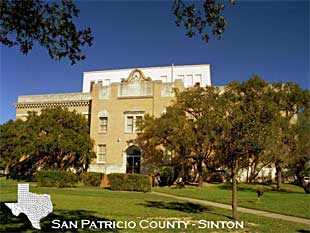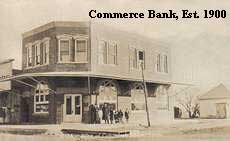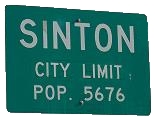History of Sinton & Police Department
We have compiled history about our community and police department and brought that information together on this page.
The Police Department Today:
 When fully staffed, the police department employs ten fulltime sworn
officers, one reserve officer, and one civilian employee. Seven of the
sworn officers are assigned to patrol, one of which is the sergeant of patrol.
There is a felony crimes detective and misdemeanor crimes detective.
When fully staffed, the police department employs ten fulltime sworn
officers, one reserve officer, and one civilian employee. Seven of the
sworn officers are assigned to patrol, one of which is the sergeant of patrol.
There is a felony crimes detective and misdemeanor crimes detective.
 The Police Department utilizes six marked patrol units and two police
mountain bikes. Every patrol unit has a radar and video camera. On an
average, the Police Department answers approximately 3,000 to 4,000 calls
a year.
The Police Department utilizes six marked patrol units and two police
mountain bikes. Every patrol unit has a radar and video camera. On an
average, the Police Department answers approximately 3,000 to 4,000 calls
a year.
The Police Department also utilizes a dual purpose Police K-9, Chris,
available to the officers 24 hours a day, seven days a week. K-9 Chris is
trained in drug detection, tracking criminals, and apprehending fleeing
criminals.
History of Sinton:
 SINTON, TEXAS. Sinton, the county seat of San Patricio
County, is at the intersection of the Southern Pacific and Missouri Pacific
railroads and U.S. highways 77 and 181, near the center of the county. Soon
after the San Antonio and Aransas Pass Railway built through the county in
1886, Col. George W. Fulton,qv founder of the Coleman-Fulton
Pasture Company,qv received approval from the board of directors
to give 640 acres for the townsite of Sinton on the south bank of Chiltipin
Creek. The town was named for David Sinton, majority stockholder in
Coleman-Fulton.
SINTON, TEXAS. Sinton, the county seat of San Patricio
County, is at the intersection of the Southern Pacific and Missouri Pacific
railroads and U.S. highways 77 and 181, near the center of the county. Soon
after the San Antonio and Aransas Pass Railway built through the county in
1886, Col. George W. Fulton,qv founder of the Coleman-Fulton
Pasture Company,qv received approval from the board of directors
to give 640 acres for the townsite of Sinton on the south bank of Chiltipin
Creek. The town was named for David Sinton, majority stockholder in
Coleman-Fulton.
The company built cattle-loading pens immediately, and a post office in the
section house was granted in 1888, with Margaret Camp as postmistress. By
1892 the post office had been discontinued. The charter for the Sinton Town
Company was granted in 1894 for 1,000 acres. The organizers proved to be
the leading citizens in the new town: George W. Fulton, Jr., John J.
Welder, David Odem, Darius Rachal, Sidney G. Borden,qv William
J. Scofield, L. N. Scofield, S. W. McCall, and S. D. Scudder.
An election made Sinton county seat on June 23, 1894, and on June 28 the
commissioners' court met in Sinton. The St. Louis, Brownsville and Mexican
Railway arrived in 1907. Growth was slow, and the population, reported as
seventy-five in 1908, began to grow only after homeseeker trains began
arriving in San Patricio County from the Midwest and from northern and
central Texas. Several blocks of land were offered for sale to farmers.
 By 1910 the town had a number of businesses, a bank, a hotel, and
a newspaper. Sinton developed as a shipping point for locally grown
vegetables after J. W. Benson arrived in the county shortly before 1908 and
set up packing sheds. Cattle continued to be shipped out by rail in large
numbers. A four-alarm fire destroyed a block of business buildings in 1912.
By 1910 the town had a number of businesses, a bank, a hotel, and
a newspaper. Sinton developed as a shipping point for locally grown
vegetables after J. W. Benson arrived in the county shortly before 1908 and
set up packing sheds. Cattle continued to be shipped out by rail in large
numbers. A four-alarm fire destroyed a block of business buildings in 1912.
The city was incorporated in 1916, and W. E. Haisley was elected mayor. A
home rule charter and a council-manager form of government were approved in
1966. A building boom transformed the main street into modern brick
buildings shortly after World War I.qv
The discovery of oil near Sinton on Easter Sunday, 1935, by the Plymouth
Oil Companyqv changed the face of the town. Plymouth set up
headquarters in Sinton and sponsored a baseball team, the Plymouth
Oilers,qv who in 1957 became the first Texas team to win the
national semiprofessional baseball crown. A few wells drilled during this
period were still in production in 1988.
After World War IIqv the city grew; a number of new businesses
and several residential developments were constructed. The economy remained
tied to the land. Vegetable-packing sheds operated in Sinton until the
mid-1960s, when sorghum, cotton, and, to a lesser degree, corn took over as
the leading crops. Ranching also continued to be important in the north and
west part of the county. A school system started in Sinton in 1893, when
Miss Drew Moore presided over the one-room school. The town now has a
modern system that was swelled by a rash of school consolidations in the
decade following World War II.
 By the 1970s Sinton was a center for farming, petroleum, and petrochemical
industries. In the 1980s the Rural Electrification Administration
maintained a regional headquarters in Sinton, and the town was the site of
a Dr Pepperqv plant. A large grain elevator served the town. The
population in the late 1980s was estimated at 6,500.
By the 1970s Sinton was a center for farming, petroleum, and petrochemical
industries. In the 1980s the Rural Electrification Administration
maintained a regional headquarters in Sinton, and the town was the site of
a Dr Pepperqv plant. A large grain elevator served the town. The
population in the late 1980s was estimated at 6,500.
Sinton is the site of the annual San Patricio County Agricultural and
Homemakers Show, an October Old Fiddlers Parade, and the county Youth
Rodeo. It is also noted for its Rob and Bessie Welder Wildlife
Park,qv a 3,000-acre recreation area belonging to the city. In
1990 the population was 5,549.
BIBLIOGRAPHY: Keith Guthrie, History of San Patricio County
(Austin: Nortex, 1986). Vertical Files, Barker Texas History Center,
University of Texas at Austin.
Keith Guthrie
Sinton Today
The player will show in this paragraph
(Video best viewed with a high speed Internet connection)


